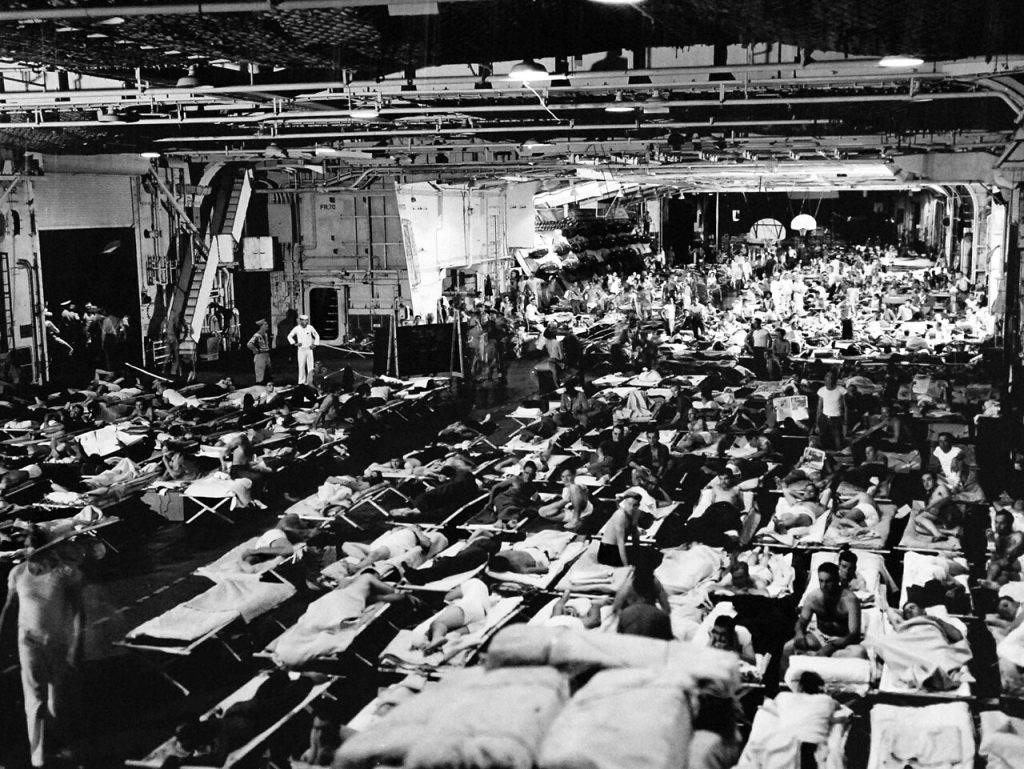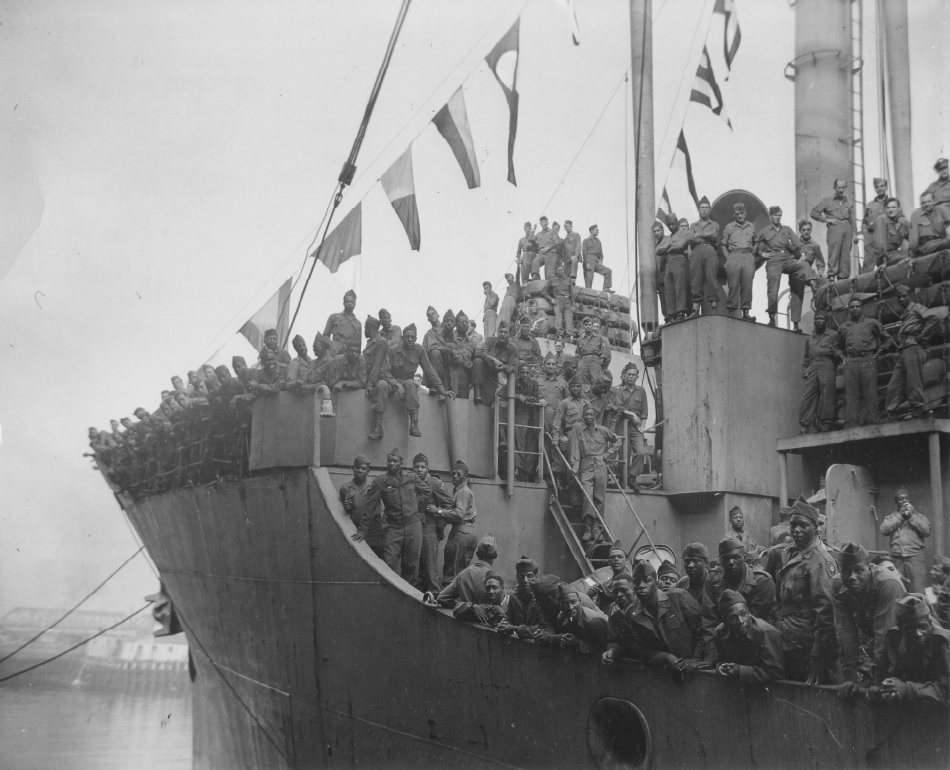
Operation Magic Carpet – Bringing The Troops Home After WW2
Operation Magic Carpet, undertaken by the United States in 1945, remains one of the most monumental and efficient troop repatriation efforts in military history.
Following the end of World War II, the U.S. faced the colossal task of returning over eight million American soldiers from the European and Pacific theaters back to the United States.
Background
During World War II, the United States had mobilized an unprecedented military force, deploying over 16 million men and women in various capacities. These forces were stationed across multiple theaters of war, including Europe, the Pacific, Africa, and Asia.
This global deployment presented a unique challenge in the war’s aftermath, as soldiers were scattered across continents, often in remote or war-torn areas.
The end of the war brought a sense of relief but also uncertainty. The U.S. government and military were under immense pressure to demobilize troops swiftly and efficiently.
 Servicemen and women on their way back home in the hangar bay of USS Intrepid.
Servicemen and women on their way back home in the hangar bay of USS Intrepid.
Soldiers, eager to return home, were growing restless in foreign lands, leading to concerns about morale and discipline. The societal pressure was immense, with families and communities across America anxiously awaiting the return of their loved ones.
The logistical challenges of returning millions of troops were compounded by the devastated infrastructure in many parts of Europe and the Pacific. Many ports, railways, and roads had been damaged or destroyed during the war, complicating the task of mass troop movement.
Execution Of Operation Magic Carpet
The operation officially began in late 1945, shortly after the end of World War II. The initial phase was focused on developing a streamlined process for the massive movement of troops.
The operation faced immediate challenges, including limited transport capacity, the need for extensive refurbishment of ships, and the coordination of departures from various global locations.
A significant number of naval vessels, including aircraft carriers, battleships, and other ships, were converted for troop transport. This process involved reconfiguring the vessels to accommodate as many soldiers as possible while ensuring their safety and basic comfort.
 USS Enterprise bringing personnel home from the Pacific, September 1945.
USS Enterprise bringing personnel home from the Pacific, September 1945.
The operation maintained a continuous flow of troop transport, with ships constantly moving between overseas locations and U.S. ports.
Many ships carried more troops than they were designed to hold, leading to overcrowded conditions. Despite these circumstances, efforts were made to maintain decent living conditions.
The troops were welcomed at various U.S. ports, where they began the process of demobilization. This process was itself a logistical challenge, involving the distribution of pay, discharge papers, and transportation to their home towns.
Conclusion Of The Operation
For many troops, the journey home was not just a physical but a psychological transition from the life of a soldier to a civilian, a process that began on these voyages.
 The Victory Ship ‘Aiken Victory’ arriving in Boston Harbor. She was carrying 1,958 troops, 26 July 1945.
The Victory Ship ‘Aiken Victory’ arriving in Boston Harbor. She was carrying 1,958 troops, 26 July 1945.
Operation Magic Carpet was largely completed by the end of 1946, having successfully repatriated the majority of U.S. troops. The operation was considered a monumental success in military logistics.
The execution of Operation Magic Carpet was a landmark achievement, showcasing the ability of the U.S. military to mobilize, execute, and manage a massive and complex logistical operation with efficiency and care for the welfare of its servicemen and women.
News
The Hanging Temple: China’s 1,500-Year-Old Cliffside Marvel of Faith and Engineering
The Hanging Temple: China’s 1,500-Year-Old Cliffside Marvel of Faith and Engineering Perched precariously on the cliffs of Mount Heng in Shanxi Province, China, the Hanging Temple, also known as Xuankong Temple, Hengshan Hanging Temple, or Hanging Monastery, is an architectural…
The Willendorf Venus: A 30,000-Year-Old Masterpiece Reveals Astonishing Secrets
The Willendorf Venus: A 30,000-Year-Old Masterpiece Reveals Astonishing Secrets The “Willendorf Venus” stands as one of the most revered archaeological treasures from the Upper Paleolithic era. Discovered in 1908 by scientist Johann Veran near Willendorf, Austria, this small yet profound…
Unveiling the Maya: Hallucinogens and Rituals Beneath the Yucatán Ball Courts
Unveiling the Maya: Hallucinogens and Rituals Beneath the Yucatán Ball Courts New archaeological research has uncovered intriguing insights into the ritual practices of the ancient Maya civilization. The focus of this study is a ceremonial offering found beneath the sediment…
Uncovering the Oldest Agricultural Machine: The Threshing Sledge’s Neolithic Origins
Uncovering the Oldest Agricultural Machine: The Threshing Sledge’s Neolithic Origins The history of agricultural innovation is a fascinating journey that spans thousands of years, and one of the earliest known agricultural machines is the threshing sledge. Recently, a groundbreaking study…
Nara’s Ancient Sword: A 1,600-Year-Old Protector Against Evil Spirits
Nara’s Ancient Sword: A 1,600-Year-Old Protector Against Evil Spirits In a remarkable discovery that has captured the attention of archaeologists and historians alike, a 7.5-foot-long iron sword was unearthed from a 1,600-year-old burial mound in Nara, Japan. This oversized weapon,…
The Inflatable Plane, Dropped Behind the Lines for Downed Pilots
Experimental The Inflatable Plane, Dropped Behind the Lines for Downed Pilots The Inflatoplane from Goodyear was an unconventional aircraft developed by the Goodyear Aircraft Company, a branch of the renowned Goodyear Tire and Rubber Company, also famed for the Goodyear…
End of content
No more pages to load











